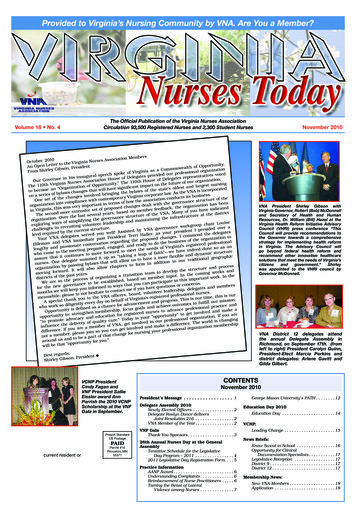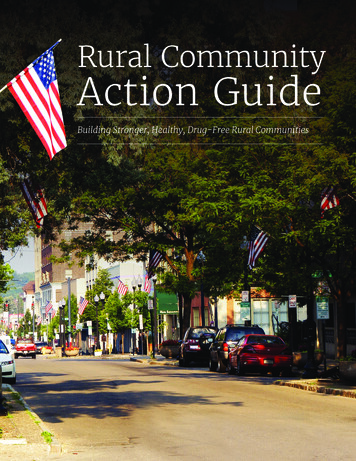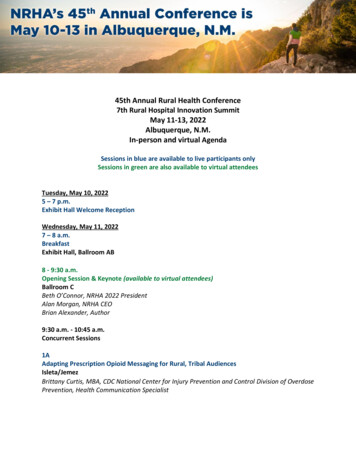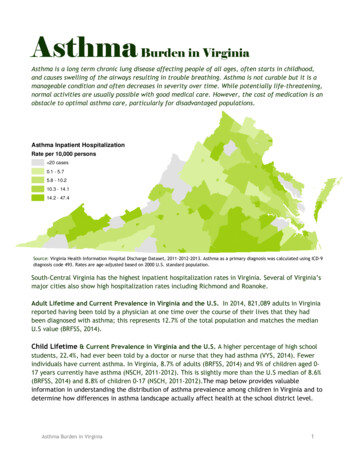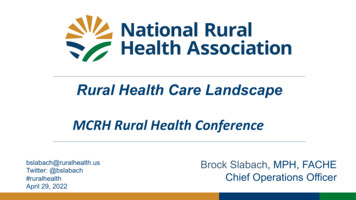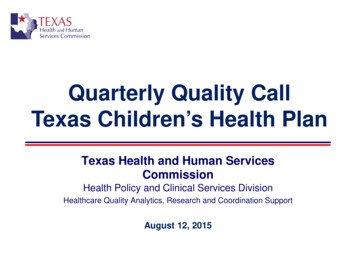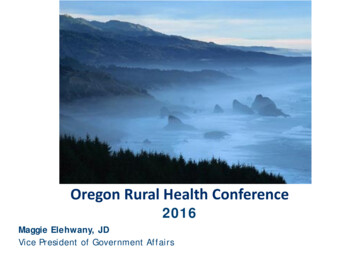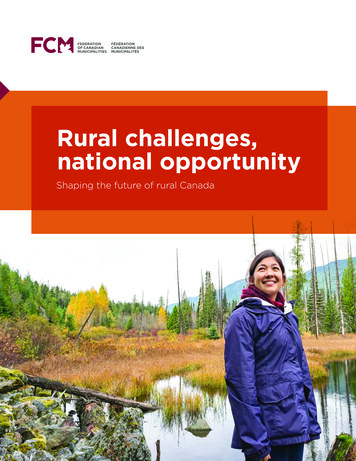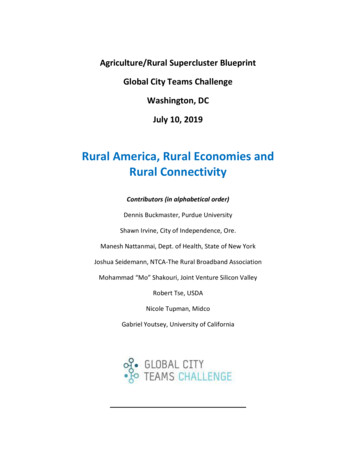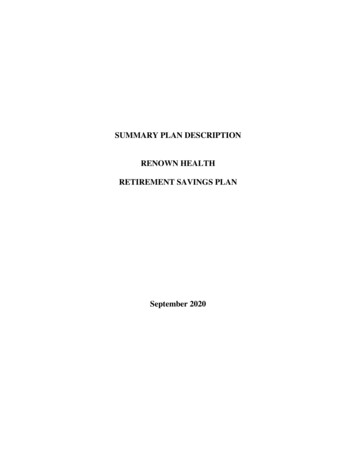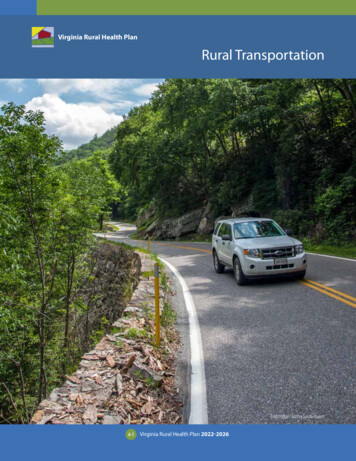
Transcription
Virginia Rural Health PlanRural TransportationRockbridge County Sarah Hauser6-1Virginia Rural Health Plan 2022-2026
Rural TransportationOverviewRural public transportation systems include demand–response public transportation (dial-a-ride), traditionaland deviated fixed route services, vanpool, andreimbursement programs (1). Traditional bus services donot operate on a round-the-clock schedule which is whythey are “often supported by demand-response services,or deviated fixed-route systems, where buses leave theirregular routes on request” (2). However, in rural areasthere is an overall lack of public transportation due tothe natural topography and increased distance betweenprivate residences and intended destinations resulting ina lack of convenient locations to place commuter stops.“While approximately 20% of the U.S. population lives inrural areas, the federal government only allocates about11% of transportation grant funding to rural areas” (3).Disproportionate transportation funding challengesthe maintenance and operational upkeep of ruraltransportation systems making them unreliable. For thesereasons, rural residents often rely on personal modes oftransportation. However, this is not a universal choice dueto the higher costs and licensure associated with owningand operating a personal vehicle. According to data fromthe US Census Bureau American Community Survey,only 2.4% of rural households have no vehicle available,compared to 2.8% of non-rural households.The transportation infrastructure of a particularcommunity both directly and indirectly influencesmultiple aspects of health. Perhaps the most obviousinfluence of transportation on health is the ability andconvenience to access goods and services that contributeto health and well-being such as grocery stores, medicalappointments, physical activity, schools, places ofemployment, and places of worship. Accordingly, accessto reliable and safe transportation is correlated with betterhealth outcomes (4).In addition to fostering a healthy community,well established transportation infrastructure is acritical economic driver. Safer and more convenienttransportation options will likely increase the amount oftravel into a community by tourists, government officials,and potential business partners. Reliable transportationinfrastructure may also increase safety and provide forthe efficient distribution of goods and services producedwithin the region. In 2019, rural communities experiencedalmost 2.5 times as many traffic fatalities per 100,000residents as non-rural communities (20.4 compared to 8.3)despite having similar commute times.Leading Practices and ApproachesWhenever possible, examples of leading practices andapproaches were taken from rural Virginia communities.Otherwise, examples were gathered from localities withcomparable demographic characteristics.The Walsh Center for Rural Health Analysis:Rural Evaluation BriefNeed addressed: Virginia’s rural population facessignificant transportation challenges. Extremely lowpopulation density paired with long travel distancescreate an environment lacking in infrastructure that wouldsupport rural public transportation (2).Traffic Fatalities per 1,000 ResidentsSource: Virginia Department of Motor Vehicles, 20196-2 Virginia Rural Health Plan 2022-2026
Rural TransportationApproach: In the spring of 2018, the Walsh Center forRural Health Analysis produced its Rural Evaluation Briefwhich listed successful practices from rural transportationprogram models already in place.The Walsh Center listed the Public Transportation Modelas one way to improve access to transportation. “Publictransportation systems provide transit services to thepublic via bus, rail, or other mode on a regular andcontinual basis” (2). Not only would the traditional modelincrease access, but variations could be considered, suchas the flex-route transportation system which allowsbuses to leave routine routes to make other stops whenrequested. To overcome transportation barriers, thereport recommended a variety of programs that wouldallow services to come directly to, or close to, those inneed. Mobile clinics, telehealth, clinics located in schoolsor workplaces, and home visiting programs were allsuggested solutions (2).The Walsh Center gave suggestions on improving theinfrastructure of rural transportation by recommendingactive transportation models, which includes activitiessuch as walking or biking to a destination. The reportshowed walking and biking are about as common in ruralareas as urban ones. To improve road safety, the WalshCenter recommended lowering speed limits on ruralroads and seeking methods to reduce response time ofemergency vehicles (2).Outcome(s): The Walsh Center provides solutionsintended to integrate well with a community’s existingprograms and resources. Rural communities shouldimplement effective strategies to increase the availabilityof transportation to accommodate the needs of olderadults, low income workers, and others who might lackadequate personal transportation, since access can impactthe health of rural communities (2).Mountain Empire Older Citizens, Inc. (MEOC)Need addressed: Rural citizens face unique transportationchallenges, especially when they are elderly. SouthwestVirginia’s twenty-one cities and counties contain adisproportionately high number of people over the ageof sixty when compared to the rest of Virginia, resulting inunique difficulties in addressing transportation needs (5).Approach: Mountain Empire Older Citizens, Inc., wascreated in 1974 to provide transportation to the elderlyliving in Scott, Lee, and Wise Counties, and the City ofNorton. MEOC directs several other organizations includingMountain Empire Transit which provides its principal modeof transporting older adults.Wise County Mountain Empire Older Citizens, Inc. TransitDue to the small population of this region of Virginia,the transit service does not have a set route and runsby request. Buses are able to accommodate those withcanes, walkers, and wheelchairs, and pick up citizens fromlocations other than a bus stop. Citizens call the numberlisted on the MEOC site to schedule a trip a full day beforethey need to be picked up. At seventy-five cents, faresare very low for minors and those over sixty. For all otheradults, the fare is one dollar and fifty cents (5).Outcome(s): MEOC's Mountain Empire Transit has helpedcountless rural community members in Southwest Virginiareach their destinations. Their by-request operation modeland low fares for the older population efficiently serves theneeds of part of Southwest Virginia.JAUNT, Inc. (JAUNT)Need addressed: It is difficult for citizens in the southwestand central regions of Virginia to find reliable publictransportation due to the large distances and lowpopulation density.Approach: Over forty years ago, JAUNT was createdto provide transportation service to citizens of six ruralcounties in Central Virginia, and the city of Charlottesville.The regional public transportation system prides itself ona comprehensive driver training curriculum and excellentcustomer service. The JAUNT fleet of transport vehicles canaverage one hundred trips each day in an area of over 2,500square miles. The system is funded by a combination of busfares, government funding, and agency payments (6).Outcome(s): JAUNT helps citizens in rural communitieswho would not otherwise have access to transportation tomake trips to medical appointments, recreational activitysites, to and from work and leisure activities, and otherdestinations. JAUNT vehicles travel over two million milesper year. According to a 2013 case study, JAUNT served314,994 riders, 83,394 of whom were considered to be ruralresidents (6).6-3 Virginia Rural Health Plan 2022-2026
Rural TransportationShore Transit and Rideshare (STAR Transit)Need Addressed: Shore Transit and Rideshare (STARTransit) serves the Eastern Shore of Virginia, comprisedof Accomack and Northampton Counties. The 70-milelong region is part of the Delmarva Peninsula and isgeographically removed from the rest of Virginia by theChesapeake Bay. The 23-mile Chesapeake Bay BridgeTunnel, part of U.S. Route 13, spans the mouth of the Bayand connects the Eastern Shore to South Hampton Roadsand the rest of the state (7).Approach: In 1996, the Virginia Department of Rail andPublic Transportation (DRPT) approved a 150,000 grantfor the Accomack-Northampton Transportation DistrictCommission (ANTDC) to initiate a public transportationsystem. The contract to operate and provide managementservices for STAR Transit was awarded to Virginia RegionalTransit (VRT) in January, 2010. VRT is “a not-for-profit501(c)(3) organization specializing in providing highquality, affordable community transportation servicesolutions” (7).Outcome(s): Most of the STAR Transit service area has apopulation of 500 persons or less per square mile. This islower than the service coverage standard of populationdensities of at least 2,000 persons per square mile;however, almost all major destinations are served by thetransit service. Concentrated transit demand is typicallyforecast by major trip generators and is then used todetermine which destinations both transit-dependentpersons and choice riders are demand most. They includehigh density housing locations such as apartments andassisted living facilities, major employers, medical facilities,educational facilities, shopping malls and plazas, grocerystores, public buildings, and human service agencies.According to Virginia’s DRPT, STAR Transit provided 82,420one-way passenger trips in 2013 (7).º This program reviews proposed enhancementprojects, executes funding agreements, trainsstaff involved in the rural transportationplanning process, and manages contracts.º The RTP was approved and certified by theSecretary and Chair of the Central VirginiaPlanning District Commission in 2020. It hascreated another proposal for the next fiscalyear which is awaiting approval (8).2. Invest in transportation infrastructure thatprioritizes physical activity such as sidewalks, bikelanes, multi-use trails, and public transit. Rural communities often lack safe and reliableopportunities for active transportation, such aswalking and bicycling. Active transportation provides the opportunity forpeople to be active throughout the day, “walkingor bicycling as a form of transportation or walkingto public transportation stations, such as bus stops,counts toward meeting the daily physical activityrecommendations” (9). This can be especially true forlow-income populations that may rely more heavilyon public transit. Less car dependency can lead to a more activecommunity and a healthier environment. Not onlydoes more active transportation increase physicalactivity, it also can help reduce the amount ofcarbon emitted into the atmosphere by singleoccupancy vehicles (10).Opportunities for Growth1. Allocate federal and state funds to supportplanning and realization of transportationinfrastructure There are deficits in available transportation innon-urbanized areas of Virginia. Federal and statefunds have not always been allocated in adequateamounts to support the creation of infrastructureand maintenance of rural transportation systems.º The Rural Transportation Planning (RTP)Program uses federal and state funding toaid in transportation planning in rural areasof the commonwealth. Federal funds areallocated as 80% of total funds so long as thelocal government can “match” and provide theother 20%.6-4 Virginia Rural Health Plan 2022-2026Roanoke Virginia Tourism
Rural Transportation3. Provide funding and technological assistance fornon-emergency transportation programs to expandaccess to employment, medical appointments,necessary errands, and community activity. Transportation programs provide rural residentswho do not otherwise have access to transportationwith the ability to participate in essential travel. The Transportation Reimbursement IncentiveProgram (TRIP) in Riverside County, California, is a“mileage reimbursement transportation service thatcomplements public transportation by encouragingvolunteer friends and neighbors to transport olderadults and people with disabilities to access medicalservices and for other purposes where no transitservice exists or when the individual is unable touse public transportation for other reasons” (11).º TRIP has been in place for over 20 years,providing over 10,000 trips a month, and wasoriginally funded in partnership between theIndependent Living Partnership (sponsor),Riverside County Transportation Commission,the Riverside County Office on Aging,foundations, and participating communities(11).º The program was named “the best volunteerdriver model in the nation” by The BeverlyFoundation in 2009 and received the 2012STAR (Senior Transportation Action Response)Award” (11).4. Apply for the U.S. Department of Veterans Affairs’Highly Rural Transportation Grants (HRTG) “Highly Rural Transportation Grants (HRTG) is agrant-based program that helps Veterans in highlyrural areas travel to VA or VA-authorized health carefacilities. This program provides grant funding toVeteran Service Organizations and State VeteransService Agencies to provide transportation servicesin eligible counties” (12). Highly Rural Transportation Grants (HRTG) providetransportation programs in counties with fewer thanseven people per square mile. There is no cost toparticipate in the program for Veterans who live inan area where HRTG is available.6-5 Virginia Rural Health Plan 2022-2026
Rural TransportationFairy Stone State Park, Patrick County VDH SORH Staff6-6 Virginia Rural Health Plan 2022-2026
non-emergency transportation programs to expand access to employment, medical appointments, necessary errands, and community activity. Transportation programs provide rural residents who do not otherwise have access to transportation with the ability to participate in essential travel. The Transportation Reimbursement Incentive
